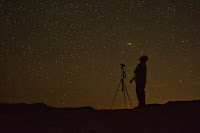Introduction and Monthly Reminders
The first two weeks of October have continued the cool and wet weather trend of the end of September. Although the weather has been pleasant to me, it is obviously not ideal for stargazing. Despite the weather, I was still able to partially view Venus, Jupiter, and Orion nearly every morning. Saturn and the Moon were also easy targets in the evening sky. I would like another opportunity for telescope use and imaging sessions before the cold settles in!
The remainder of October will bring a planetary conjunction between Mars and Mercury on the 21st and the return of the Orionid Meteor Shower on the same day. There are also a couple of visible comets, and since comets are so unpredictable, they may even become visible to the naked eye during the next few weeks. The first is Comet SWAN, which can be found near Ophiuchus next to the southern Milky Way Band after sunset. Comet SWAN will travel eastward every night and end the month in Aquarius. This comet will grow fainter as it travels eastward, away from the Sun, and will require binoculars to view.
Comet Lemmon can be viewed in the northern sky near Ursa Major after sunset on the 15th, but it will travel westward every day and end the month in Serpens. As the night progresses, Comet Lemmon will dip below the horizon, but will return before sunrise for another chance to be viewed. Comet Lemmon will brighten as the end of the month nears, but currently requires binoculars or a telescope to see. Both comets can be captured on camera with a long exposure image.
Capitol Reef Experience
My recent trip to Capitol Reef National Park was fantastic, and I highly recommend it for stargazing, astrophotography, hiking, camping, and even a quick getaway. Although my trip was plagued with clouds and rain every day, it was still a spectacular experience. For those who don't know, Capitol Reef is located in southeastern Utah and shares the red rock color of Zion's National Park, Bryce Canyon, Cedar Breaks, and many other state and national parks in central and southern Utah. The red rocks and vast landscape of this region attract millions of visitors every year.
This was my first trip to Capitol Reef, and I hope it will be the first of many. I was fortunate enough to enjoy the red color in both direct sunlight and stormy weather, each offering its own uniqueness. We arrived on a cloudy Thursday afternoon, which turned to rain just as we climbed into our tent for the night. The sound of the rain on the tent made it easy to fall asleep.
The next morning, almost the entire group we were with went on a water hike. Water shoes were recommended, but it's easy to do without them. The clouds came and went through most of the hike, with rain holding off until we returned to the cars. After this hike, we went on another hike to view some petroglyphs.
 |
| Capitol Reef Water Hike with Storm Clouds |
 |
| Petroglyphs at Capitol Reef |
That night, we were able to set up the smart telescope and were persistently requested to do so to see what we could view. It was windy all night, and I was hesitant to set up the scope, but Friday night turned out to be the only cloud-free night we would get during the trip. Everyone was pleased with the images and ecstatic that I set up the scope. We viewed Albireo, a double star, but unfortunately, the two stars were too close together for the smart telescope to resolve. I then switched to M31, but unfortunately, the wind prevented a clear image of our neighboring galaxy. Fortunately, these were the only two objects that I was unable to image. We didn't look at many objects, but let the telescope take several images over a long period of time to enhance the view of each target. I must preface that these images could have been better if it were not for guests shining lights around the equipment, but here are the best images.
 |
| M13, the Hercules Cluster |
 |
| NGC281, the Pacman Nebula |
 |
| M57, the Ring Nebula |
 |
| M27, the Dumbbell Nebula |
Saturday was our last day in Capitol Reef. We went on a hike to the Hickman Natural Bridge, seen below, and a lovely drive along the recently reopened Scenic Drive Road in the rain.
 |
| Hickman Natural Bridge |
Saturday night brought in another thunderstorm, but I was able to capture a few more images with my phone.
 |
| Northern Milky Way Band and Andromeda |
We left early Sunday morning to visit Bryce Canyon. Despite the cold temperatures and rain, this park was crowded! The crowds and fog prevented us from seeing much of the park, so I am anxious to revisit this place. Below are a few of the pictures I took.
 |
| Scenic View |
 |
| Hoodoos at Bryce Canyon |
I hope these pictures are appreciated and inspire my readers to visit these and other national parks to enjoy the night sky and their beauty. Pictures can't do the views justice.






